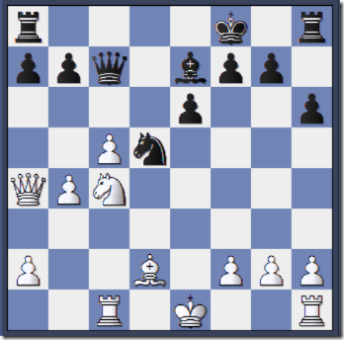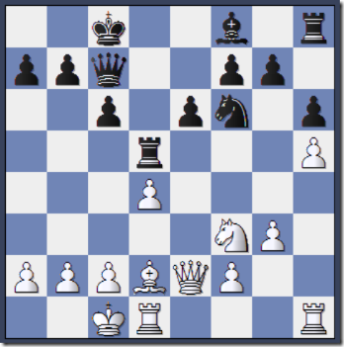FIDE candidates matches: Game three preview
1. Carlsen - Aronian
In the first game, Carlsen played the Anti Marshall already on move five (5.d3). As I said in my preview of this match: "In fact Aronian seems to be very comfortable in these positions with Black and scores very well there." In fact Aronian had no problems with the opening and won a nice game.
If Carlsen has prepared something against the Marshall I see no reason not to play it in the first game. I think Carlsen will play 1.d4 tomorrow.
2. Leko - Gurevich
As expected, in the first game we saw the French with 1.e4 e6 2.d4 d5 3.Nc3 Nf6 4.Bg5 dxe4. In the line played, in the following position
Gurevich was no longer able to castle, but found a nice way to bring his rook into play with 19..h5 followed by ..h4 and ..Rh5. Is is not easy to see how White should get an advantage then, and the game ended in a draw.
I think Leko will have prepared more than one line against this French, and would choose another one. However, since Gurevich lost the second game with White and is behind in the match, he may also play 1..d6.
3. Ponomariov - Rublevsky
Ponomariov played 1.d4 and Rublevsky chose the same line in the Slav that Kramnik used against Topalov in their world championship match last year. Of course Rublevsky was a second for Kramnik during that match and must have participated in the analysis of this line during preparation with Kramnik.
On move 13 Rublevsky played 13..Rc8 14.Ba2 a5, where Kramnik had played 13..a6. I don't know if a recent loss in this line by Kramnik against Aronian in their rapid match was so frightening for Black, or if this is just an alternative, in any case Rublevsky didn't look in any danger in this game.
I think Ponomariov is going to play 1.e4 in game three, as reasoned in my preview of this match.
4. Gelfand - Kasimdzhanov
Kasimdzhanov surprisingly played the Slav in the first game. Gelfand was pressing throughout the game but wasn't able to win. I am sure White's play can be improved - Kasimdzhanov should play different early in the game.
5. Kamsky - Bacrot
I was a bit surprised that Kamsky played 1.d4, but because he managed to take the lead in game 2 with Black, there is no reason for him to change strategy.
I don't know if Bacrot has prepared a riskier opening against 1.d4 for this match. Kamsky playing the Dutch in the second game makes you wonder if he has prepared more surprises for Bacrot.
6. Grischuk - Malakhov
I don't know why Malakhov avoided his usual Gurgenidze drawing weapon in the first game - Malakhov was probably wondering too, after the ugly position he got out of the opening.
Because he didn't manage to win the second game I am not sure going back to the drawing weapon would be the right choice in such a short match.
Maybe we will see 1.e4 c5 2.Nf3 g6 which Malakhov played a few times with success - albeit against much weaker opposition.
7. Polgar - Bareev
In the Caro-Kann main line after
1.e4 c6 2.d4 d5 3.Nc3 dxe4 4.Nxe4 Bf5 5.Ng3 Bg6 6.h4 h6 7.Nf3 Nd7 8.h5 Bh7 9.Bd3 Bxd3 10.Qxd3 e6 11.Bf4 Qa5+ 12.Bd2 Qc7 13.O-O-O O-O-O 14.Ne4 Ngf6 15.g3 Nxe4 16.Qxe4 Nf6 17.Qe2
Bareev played the interesting side line 17..Rd5.
I am sure Judith Polgar didn't know this move. She spent a very long time considering her next move and then played the inferior
18.Ne5? Rxd4 19.Bf4 Re4 20.Qd3 Bc5 21.Ng6 Rxf4 22.Nxf4
when Black was already slightly better.
There are two better moves for White here:
A) 18.Bf4
Khalifman analyses this move on two densely filled pages of his excellent book "Opening for White according to Anand, part 3".
A1) 18..Qa5 19.c4 Rxh5 20.Ne5
Khalifman analyses 20.Rxh5 to an advantage, but this seems simpler.
20..Rxh1 21.Rxh1 Bd6 22.Nxf7 Bxf4+ 23.gxf4 Qxa2
Here Khalifman cites a game between two computers that ended in a draw after 24.Qxe6+ and says "it is amazing, but we failed to find an improvement for White". However, my Fritz gives
24.Rh3 as winning.
A2) 18..Bd6
This seems to be the only move, then. Here Khalifman suggests 19.Be5 with a small advantage for White.
B) 18.c4
Now after 18..Rxh5 there are two ideas for White:
B1) 19.Bf4
After 19..Qa5 20.Bf4 we would transpose to line A1 above, therefore Black has to play 19..Qe7. Black's pieces are a bit in a tangle now, but I don't see how White can exploit this.B2)
19.Rxh5 Nxh5 20.Qe5 Qxe5 21.dxe5
Now White threatens to win the "knight on the rim" with g4, and Black has to make some concessions. It looks as if White can regain the pawn, but I am not sure if there is much more.
8. Adams - Shirov
Shirov surprised with the French. Maybe he thought Adams' 3.Nd2 not so dangerous for Black. Indeed he seemed to equalize completely - I think the complications later were unrelated to the opening. Adams' 12.g3 is a rare line, but Shirov was apparently well prepared with 14..Ne4. Maybe Adams will try the main line 12.Bg5 in the next game? Or Shirov will surprise us again with another opening.
Labels: chess




0 Comments:
Post a Comment
<< Home